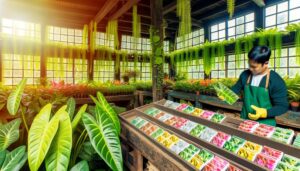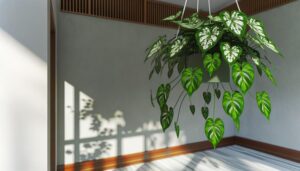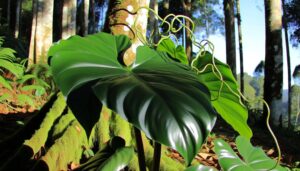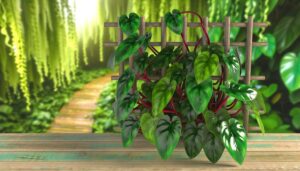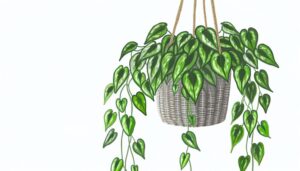What Are the Characteristics of Philodendron Serpens X Verrucosum?
Philodendron Serpens X Verrucosum features heart-shaped leaves with a soft texture and prominent feather-like veining. The leaves exhibit an emerald green hue, with deep red or burgundy undersides.
The stem showcases a verrucate texture with deep green to reddish tones and hair-like trichomes. This hybrid thrives in bright, indirect light and requires high humidity (70%-90%).
Optimal growth occurs in well-draining soil with high organic content, maintained at temperatures between 65°F to 80°F. Regular monitoring for pests such as spider mites and mealybugs is essential.
For a deeper understanding of its care and growth kinetics, continue exploring further.
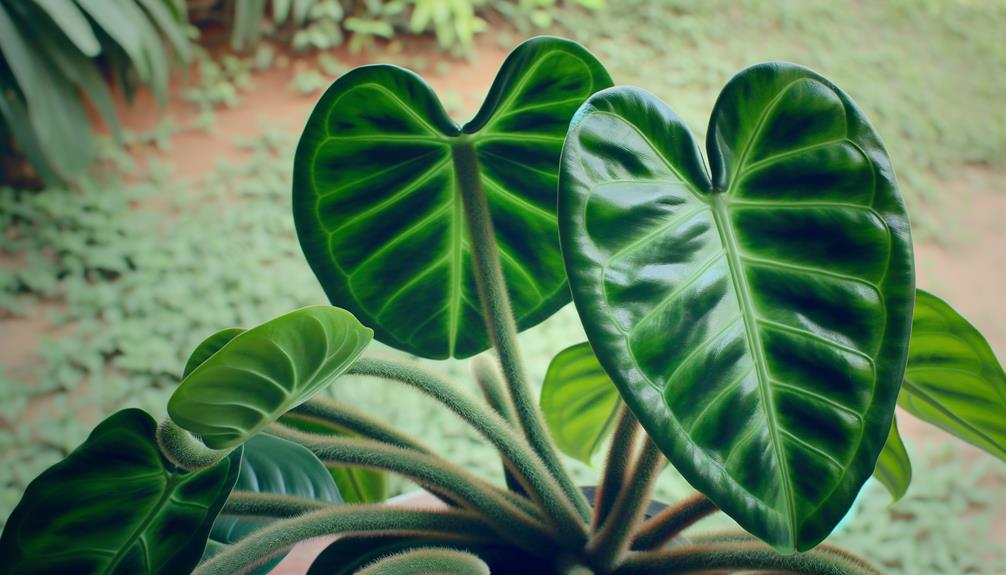
Key Takeaways
- Heart-shaped leaves with soft texture, emerald green color, and deep red undersides.
- Verrucate stems with rough and velvety surfaces featuring hair-like trichomes.
- Vigorous growth with rapid leaf emergence and compact internodal spacing.
- Thrives in bright, indirect sunlight and high humidity levels between 70% and 90%.
- Well-draining soil with high organic content and a pH between 5.5 and 6.5.
Leaf Shape and Texture
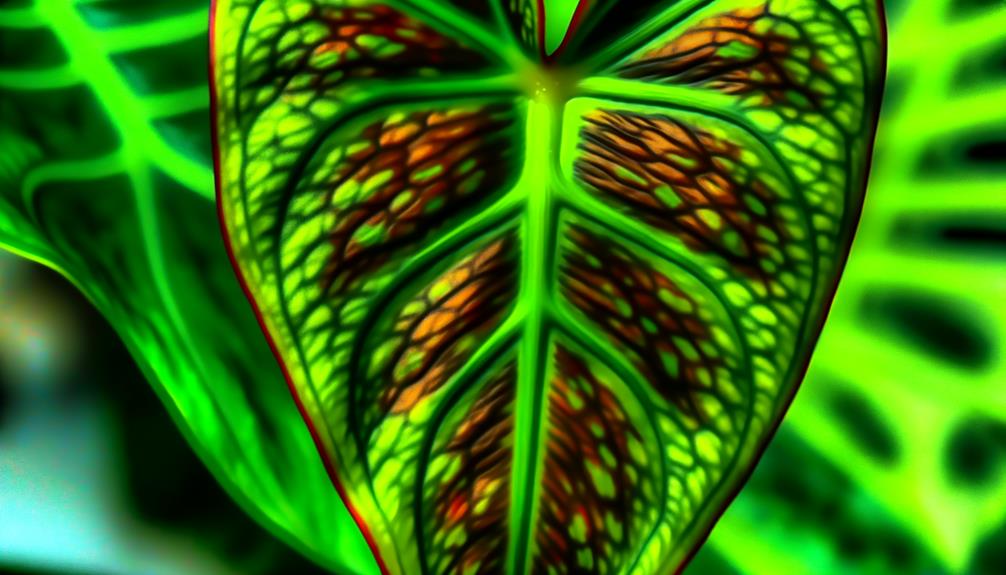
The leaves of the Philodendron Serpens X Verrucosum display a heart-shaped structure with a soft texture that is characterized by noticeable veining and a slightly wrinkled surface. This structure allows for optimized surface area, enhancing photosynthetic efficiency.
The soft texture is a result of the presence of delicate trichomes, which may serve to decrease water loss and deter herbivory. The noticeable veining, usually arranged in a feather-like pattern, ensures efficient nutrient transport across the leaf.
The slightly wrinkled surface increases the leaf's structural integrity and may assist in water distribution during rainfall. These features collectively contribute to the plant's adaptability in its natural environment, highlighting both visual appeal and functional efficiency.
Color and Patterns
Additionally, the Philodendron Serpens X Verrucosum exhibits a striking array of colors and patterns that further enhance its visual appeal and functional adaptations.
The leaves showcase a rich, emerald green hue that is accentuated by contrasting deep red or burgundy undersides, creating a visually engaging two-tone effect.
Prominent, white to pale green veins run through the foliage, forming intricate patterns that add to its ornamental value. These variegations not only provide aesthetic benefits but may also play a role in optimizing photosynthesis by maximizing light capture.
The dynamic coloration and veining patterns are characteristic of this hybrid, making it a favored choice among horticulturists and plant enthusiasts who appreciate its unique and vibrant appearance.
Stem Features
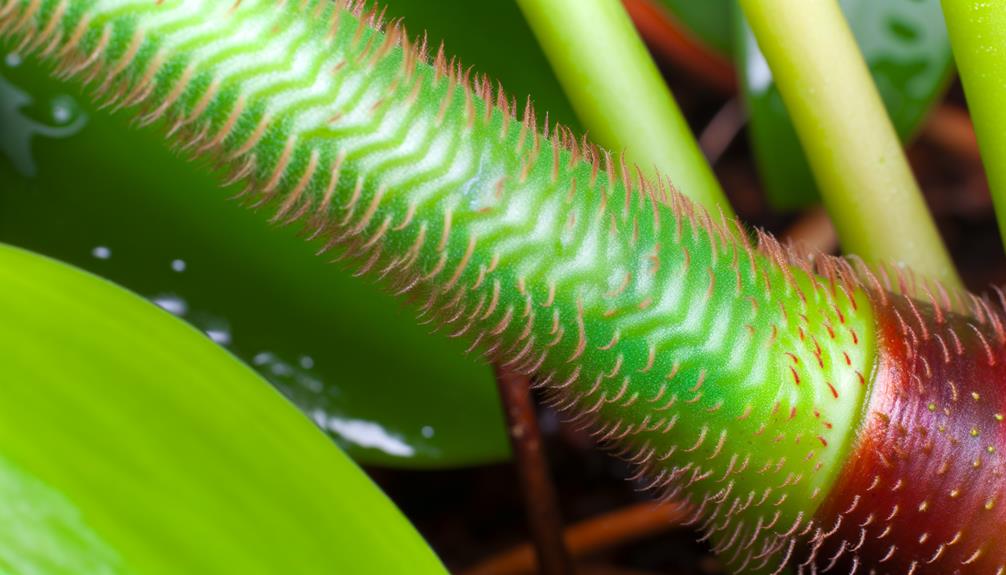
The stem of Philodendron Serpens X Verrucosum exhibits a distinctive texture characterized by its pronounced verrucate (wart-like) surface. Its coloration ranges from deep green to reddish hues, often accompanied by intricate patterns that enhance its visual appeal.
Additionally, this hybrid demonstrates a climbing growth habit, utilizing aerial roots to anchor itself to supports.
Unique Stem Texture
Frequently noted for its distinctive texture, the stem of Philodendron Serpens X Verrucosum exhibits a unique combination of rough and velvety surfaces that set it apart from other species.
This hybrid plant showcases a stem adorned with fine, hair-like trichomes, contributing to its velvety feel. The rough texture is attributed to the presence of small, wart-like protuberances called verrucae, which are characteristic of one of its parent species, Philodendron Verrucosum.
These textural elements not only enhance the plant's tactile appeal but also play a role in its ecological interactions, potentially aiding in moisture retention and deterring herbivory. The juxtaposition of these textures provides a compelling visual and sensory experience, making it a sought-after specimen in botanical collections.
Color and Pattern
Showcasing a rich palette of hues, the stem of Philodendron Serpens X Verrucosum often exhibits a blend of deep greens, reddish undertones, and subtle variegation, contributing to its intricate visual appeal.
The deep green coloration, often interspersed with reddish tones, provides a striking contrast that accentuates the plant's overall aesthetics.
Variegation patterns, though subtle, introduce an additional layer of complexity to the visual texture. The stem's surface may display minute variations in hue, creating a nuanced gradient effect that appears dynamic under varying light conditions.
This chromatic interplay is enhanced by the presence of fine, hair-like structures, which can add a silvery sheen, further intensifying the stem's distinctive appearance.
Growth Habit
Characterized by a robust and climbing growth habit, the stem of Philodendron Serpens X Verrucosum exhibits a unique combination of flexibility and strength, enabling it to anchor effectively to various supports. The stem features are integral to its adaptability and resilience, allowing it to thrive in diverse environments.
Key characteristics of the stem include:
- Aerial Roots: These roots emerge along the stem, aiding in attachment to surfaces and absorption of moisture and nutrients from the air.
- Internode Length: Variable internode lengths provide structural flexibility, facilitating efficient space utilization.
- Stem Texture: The stem surface is typically covered with fine, protective trichomes, which contribute to its durability and resistance to physical damage.
These features collectively guarantee the plant's vigorous and sustained growth.
Growth Rate
The growth rate of Philodendron Serpens X Verrucosum is remarkably vigorous under ideal conditions, characterized by rapid leaf emergence and stem elongation.
This hybrid philodendron can exhibit a notable increase in both foliage density and vine length, given excellent humidity, nutrient availability, and temperature.
Typically, new leaves unfurl at intervals of approximately two to three weeks, contingent upon environmental stability.
The plant's internodal spacing remains compact, resulting in a lush, dense appearance.
Additionally, the adventitious roots develop swiftly, enhancing the plant's ability to absorb moisture and nutrients more effectively.
Understanding its growth kinetics is essential for horticulturists aiming to cultivate this hybrid successfully, ensuring that the conditions are meticulously tailored to sustain its robust growth dynamics.
Ideal Light Conditions
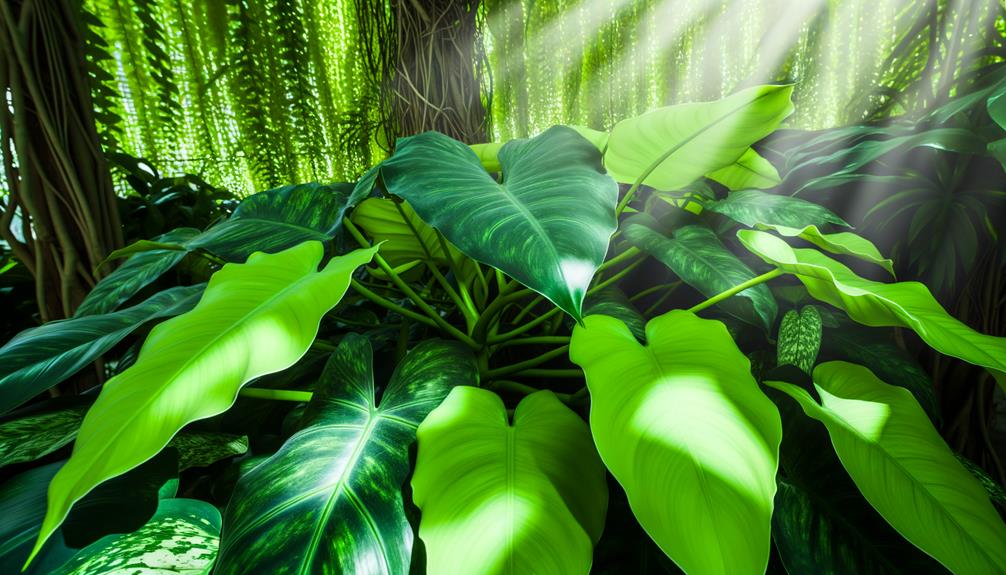
Philodendron Serpens X Verrucosum thrives most under conditions of bright, indirect sunlight, as direct sun exposure can cause leaf scorching and hinder growth.
Best placement includes areas with filtered light or partial shade.
Ensuring the plant receives consistent, diffused light will maintain its vibrant foliage and overall health.
Indirect Sunlight Preference
For best growth, Philodendron Serpens X Verrucosum thrives best under bright, indirect sunlight, which mimics the dappled light conditions of its native tropical habitat. This plant's photosynthetic needs are optimized under filtered light, which can be achieved through several methods:
- Placement: Position the plant near an east-facing window where it can receive morning light, but is shielded from the harsher afternoon sun.
- Sheer Curtains: Use sheer curtains to diffuse direct sunlight, ensuring that the plant receives consistent, gentle light throughout the day.
- Artificial Lighting: Employ full-spectrum grow lights if natural light conditions are inadequate, maintaining a distance of 12-18 inches to prevent leaf burn.
These conditions will facilitate healthy growth and vibrant foliage.
Avoid Direct Sun Exposure
While bright, indirect sunlight is ideal, it is crucial to avoid placing Philodendron Serpens X Verrucosum in direct sun exposure to prevent leaf scorch and potential damage to its delicate foliage. Direct sunlight can cause photodamage, leading to chlorophyll degradation and resultant browning or yellowing of the leaves.
Best light conditions for this hybrid involve positioning it in a location where it receives filtered light, such as near a north-facing window or behind a sheer curtain. Light levels should be consistent to mimic its natural understory habitat, ensuring the plant thrives.
Additionally, rotating the plant periodically ensures even light distribution, preventing asymmetric growth and maintaining its aesthetic appeal and health.
Watering Needs
Maintaining ideal hydration for Philodendron Serpens X Verrucosum requires a delicate balance, ensuring the soil remains consistently moist but not saturated to prevent root rot. Adequate watering can be achieved by adhering to the following guidelines:
- Soil Moisture Monitoring: Regularly check the top inch of soil. If it feels dry to the touch, it is time to water.
- Water Quality: Use room-temperature, distilled, or rainwater to avoid mineral buildup that can harm the plant.
- Drainage: Guarantee the pot has sufficient drainage holes to prevent water from pooling at the bottom, which can lead to root rot.
Consistently following these practices will help maintain the best hydration level necessary for the health and growth of Philodendron Serpens X Verrucosum.
Temperature Preferences
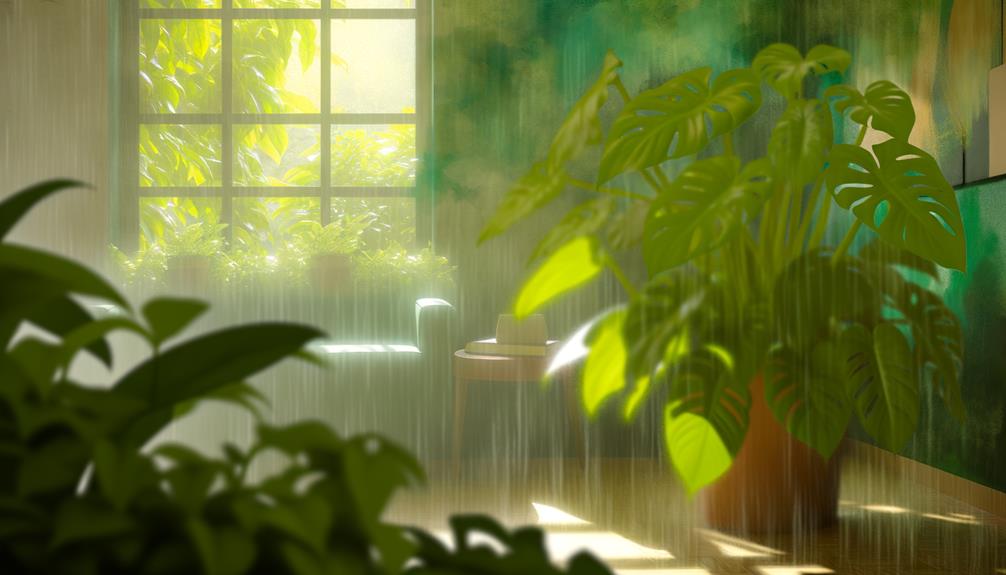
Philodendron Serpens X Verrucosum flourishes best in temperatures ranging from 65°F to 80°F, requiring a consistently warm environment for optimal growth. This hybrid needs a stable thermal condition, as fluctuations can stress the plant, leading to suboptimal growth and potential health issues.
Maintaining temperatures within this range supports its metabolic processes, photosynthetic efficiency, and overall physiological functions. It is essential to avoid exposing the plant to temperatures below 60°F, as this can cause cellular damage and hinder recovery.
Conversely, temperatures above 85°F may lead to heat stress, manifesting in wilting or leaf scorch. Hence, careful monitoring and regulation of ambient temperature are vital for promoting the thriving health and development of Philodendron Serpens X Verrucosum.
Humidity Requirements
Adequate moisture levels are crucial for the Philodendron Serpens X Verrucosum, with an ideal range between 70% and 90% to replicate its native tropical environment. High humidity promotes leaf growth and prevents drying out. Maintaining such levels can be achieved through several methods:
- Humidifiers: Using electric humidifiers can uphold consistent humidity, especially in dry indoor climates.
- Misting: Regularly misting the plant's foliage can provide short-term relief, although it may not sustain high moisture for extended periods.
- Humidity Trays: Placing the plant on a tray filled with water and pebbles can help increase ambient moisture through evaporation.
Regular monitoring with a hygrometer is recommended to ensure the plant remains within its preferred moisture range.
Soil Type

A well-draining, aerated soil mix with a high organic content is vital for the best growth of Philodendron Serpens X Verrucosum. This hybrid species thrives in a substrate that allows efficient water drainage while retaining sufficient moisture.
A recommended soil composition would include a blend of peat moss, perlite, and orchid bark, which ensures ideal aeration and root health. The inclusion of organic matter, such as compost or worm castings, provides necessary nutrients and enhances microbial activity.
The soil pH should ideally range between 5.5 and 6.5, slightly on the acidic side, to facilitate nutrient uptake. Regularly monitoring the soil's condition is essential to avoid waterlogging and root rot, thereby maintaining a healthy growing environment for this philodendron hybrid.
Common Pests and Diseases
Maintaining ideal soil conditions is fundamental, but growers must also be attentive about common pests and diseases that can afflict Philodendron Serpens X Verrucosum. This hybrid is susceptible to several issues that can compromise its health:
- Spider Mites: These tiny arachnids thrive in dry conditions and cause yellowing leaves and webbing.
- Mealybugs: These pests secrete a waxy, white substance and can lead to stunted growth and leaf deformities.
- Root Rot: Overwatering or poor drainage can lead to this fungal disease, characterized by blackened, mushy roots and wilting foliage.
Effective pest management and early detection are critical. Regularly inspect plants and employ integrated pest management strategies to mitigate these common threats, ensuring the plant's longevity and well-being.
Conclusion
To sum up, the Philodendron serpens x verrucosum, with its distinctive leaf shape, textured foliage, and striking color patterns, embodies botanical elegance. Its unique stem features, coupled with a moderate growth rate, require specific light, temperature, and humidity conditions for ideal development.
Prone to certain pests and diseases, this hybrid thrives in well-draining, nutrient-rich soil. Like a maestro orchestrating a symphony, proper care harmonizes these elements, ensuring the plant's vibrant health and aesthetic appeal.

